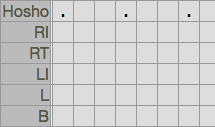Mbira dzavadzimu (with extra keys)
This instrument class offers notations for the mbira dzavadzimu with all sorts of additional keys or manuals, e.g a LI left index finger manual. It is a work in progress - if you would like to transcribe pieces using extension keys which are not yet supported, get in touch. For transcriptions with extensions such as the common extra bass key and higher index keys, the basic mbira davadzimu class is already sufficient. However, there a difference in how that bass key is handled on translation. There are the same three notations as for the mbira dzavadzimu without extra keys:- Position
- Pitch
- Pitch+Octaves
|

|
Key Overview
The table below shows all keys of the notation, from lowest to highest. Each row contains all possible keys for that playing area. Each column contains all keys of the same pitch. Not all instruments may have keys matching all these notes. Red notes are alias names for the same key, if it can be played with different fingers.| Hosho | . | ||||||||||||||||||||||||||
| RI | 4 | 5 | 6 | 7 | 8 | 9 | 10 | 11 | 12 | 13 | |||||||||||||||||
| RT | L1 | 1 | -2 | -1 | 2 | 3 | 4 | 5 | 6 | ||||||||||||||||||
| LI | 1 | 2 | 3 | ||||||||||||||||||||||||
| L | 1 | RT1 | 3 | 2 | 4 | 5 | 6 | 7 | |||||||||||||||||||
| B | 1 | 2x | 2 | 3 | 4 | 5 | 6 | 7 |
Aliases
The table below lists all alias keys. Row names are shown in black, cell content in red.| Key | Alias | Notes |
|---|---|---|
| L1 | RTL1 | L1 key played with the right thumb |
| RT1 | LRT1 | RT1 key played with the left thumb |
| RI4 | RT4 | RI4 key played with the thumb instead of the index finger |
| RI5 | RT5 | RI4 key played with the thumb instead of the index finger |
| RI6 | RT6 | RI4 key played with the thumb instead of the index finger |
Key Overview
The table below shows all keys of the notation, from lowest to highest. Each row contains all possible keys for that playing area. Each column contains all keys of the same pitch. Not all instruments may have keys matching all these notes. Red notes are alias names for the same key, if it can be played with different fingers.| Hosho | . | ||||||||||||||||||||||||||
| RI | 3 | 4 | 5 | 6 | 7 | 1 | 2 | 3'' | 4'' | 5'' | |||||||||||||||||
| RT | L1 | 3 | 6 | 7 | 1 | 2 | 3' | 4 | 5 | ||||||||||||||||||
| LI | 3 | 1 | 2 | ||||||||||||||||||||||||
| L | 1 | RT3 | 4 | 5 | 6 | 7 | 1' | 2 | |||||||||||||||||||
| B | 1 | 2, | 3 | 4 | 5 | 6 | 7 | 2 |
Aliases
The table below lists all alias keys. Row names are shown in black, cell content in red.| Key | Alias | Notes |
|---|---|---|
| L1 | RTL1 | L1 key played with the right thumb |
| RT3 | LRT3 | RT3 key played with the left thumb |
| RI3 | RT3' | RI3 key played with the thumb instead of the index finger (Note the RT3', as there is also RT3) |
| RI4 | RT4 | RI4 key played with the thumb instead of the index finger |
| RI5 | RT5 | RI5 key played with the thumb instead of the index finger |
Key Overview
The table below shows all keys of the notation, from lowest to highest. Each row contains all possible keys for that playing area. Each column contains all keys of the same pitch. Not all instruments may have keys matching all these notes. Red notes are alias names for the same key, if it can be played with different fingers.| Hosho | . | ||||||||||||||||||||||||||
| RI | 3' | 4' | 5' | 6' | 7' | 1'' | 2'' | 3'' | 4'' | 5'' | |||||||||||||||||
| RT | 1 | 3 | 6 | 7 | 1' | 2' | 3' | 4' | 5' | ||||||||||||||||||
| LI | 3 | 1' | 2' | ||||||||||||||||||||||||
| L | 1 | 3 | 4 | 5 | 6 | 7 | 1' | 2' | |||||||||||||||||||
| B | 1, | 2, | 3, | 4, | 5, | 6, | 7, | 2 |
Aliases
The table below lists all alias keys. Row names are shown in black, cell content in red.| Key | Alias | Notes |
|---|---|---|
| L1 | RT1 | L1 key played with the right thumb |
| RT3 | L3 | RT3 key played with the left thumb |
| RI3' | RT3' | RI3' key played with the thumb instead of the index finger |
| RI4' | RT4' | RI4' key played with the thumb instead of the index finger |
| RI5' | RT5' | RI5' key played with the thumb instead of the index finger |